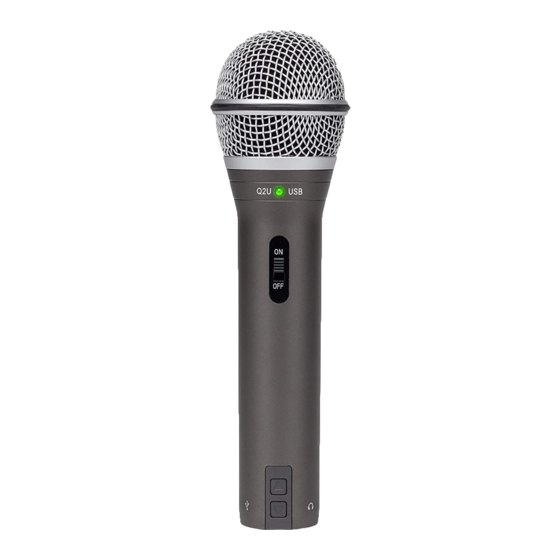Advertisement
Table of Contents
Advertisement
Table of Contents

Summary of Contents for Samson Q2U
- Page 1 Owner's Manual...
- Page 2 The Q2U combines the convenience of digital and analog audio capture into one microphone. With XLR and USB outputs, the Q2U is the easily fits into your home studio and mobile recording, as well as stage performance. The pack includes a desktop tripod stand, mic clip, foam wind- screen, XLR cable and USB cable...everything you need to start recording right out of the box.
- Page 3 Q2U Layout Windscreen – Dual stage grill protects the capsule and helps reduce wind noise and p-popping. Capsule – Internally shock mounted dynamic microphone element with cardioid pick up pattern. LED – The dual color Power/Clip LED lights green to indicate power, and flashes red when the input mic is overloaded or clipping.
- Page 4 Select the Sound preference icon, choose the Input tab and select Q2U. Set the gain of the Q2U by adjusting the Input volume slider at the bottom of the Sound dialog box. Set the Q2U as playback volume by clicking the Output tab and select Q2U, adjust the Output volume slider at the bottom of the Sound dialog box to the maximum setting and use the Q2U’s front panel Volume knob to control the overall output from the headphones or speakers.
-
Page 5: Quick Start
Q2U and plug the other end of the cable into an available USB port on your computer. Launch your recording software, turn down the main output level and select the Q2U for the input and out- puts. Set up a mono record track in your software. -
Page 6: Microphone Placement
In order to maximize the quality of your recordings, you should pay careful attention to the placement and positioning of the Q2U for the instrument or vocalist that you are miking. The Q2U is a unidirectional microphone with a cardioid pickup pattern. Cardioid microphones, exhibit a phenomenon known as proximity effect. -
Page 7: Stand Mounting
This allows you to raise the height of the microphone towards the performers mouth. Additionally, the Q2U can be mounted to any standard microphone stand using the included mic clip. Simply screw the Q2U mic clip on to your mic stand or boom arm and adjust the microphone to the desired angle. - Page 8 300° 60° microphone reacts to different frequencies. The Q2U is a unidirectional microphone which captures 90° 270° sound in front of the microphone and rejects sound from the sides and back. This allows for better separation of performers or instruments in the studio, and picks up 120°...
-
Page 9: Specifications
Dimensions ... . 7.5 ” x 2.2 ” (diameter) / 190 mm x 55 mm (diameter) At Samson, we are continually improving our products, therefore specifications and images are subject to change without notice. -
Page 10: Important Safety Information
Important Safety Information Note: This equipment has been tested and found to comply with the limits for a Class B digital device, pursuant to Part 15 of the FCC rules. These limits are designed to provide reasonable protection against harmful interference in a residential installation. This equipment generates, uses and can radiate radio frequency energy and, if not installed and used in accordance with the instructions, may cause harmful interference to radio communications. - Page 11 WARNING: Listening to music at high volume levels and for extended durations can damage one’s hearing. In order to reduce the risk of damage to hearing, one should lower the volume to a safe, comfortable level, and reduce the amount of time listening at high levels. Please use the following guidelines established by the Occupational Safety Health Administration (OSHA) on maximum time exposure to sound pressure levels before hearing damage occurs.
- Page 12 Samson Technologies Corp. Copyright 2016 278-B Duffy Ave Hicksville, New York 11801 Phone: 1-800-3-SAMSON (1-800-372-6766) Fax: 631-784-2201 www.samsontech.com v5.0...















Need help?
Do you have a question about the Q2U and is the answer not in the manual?
Questions and answers
why can't i use this mic on call of duty to chat?